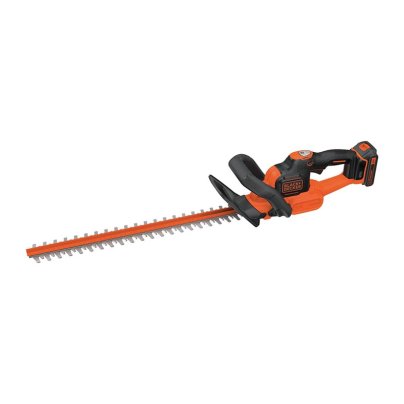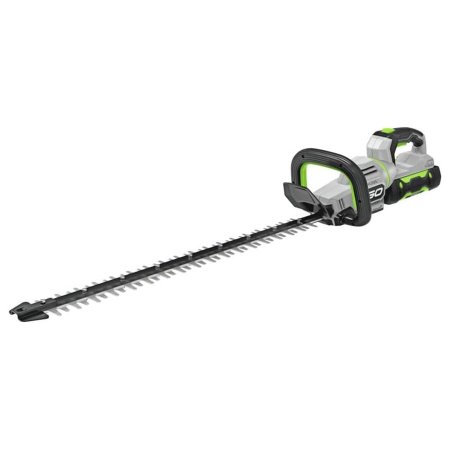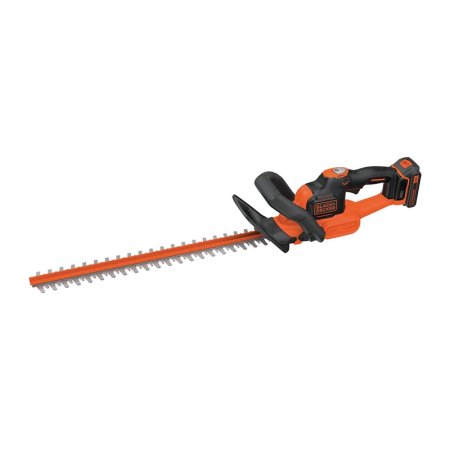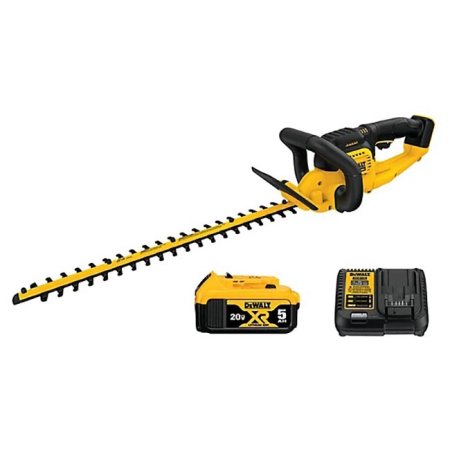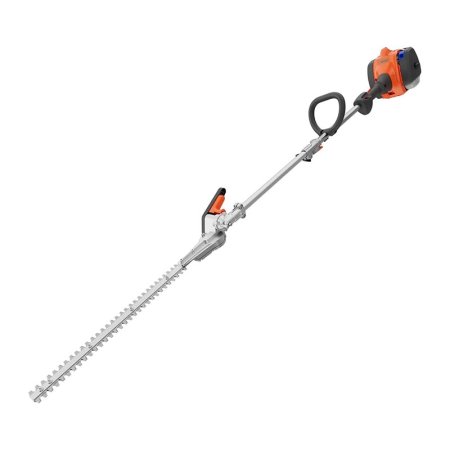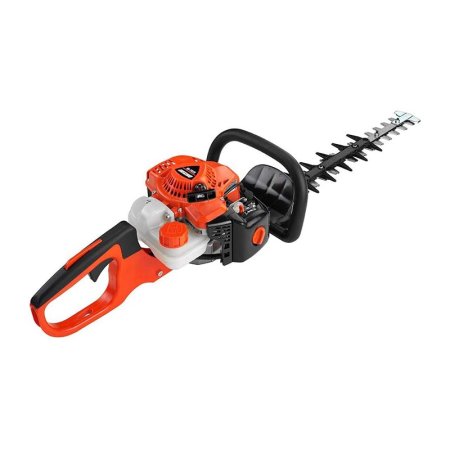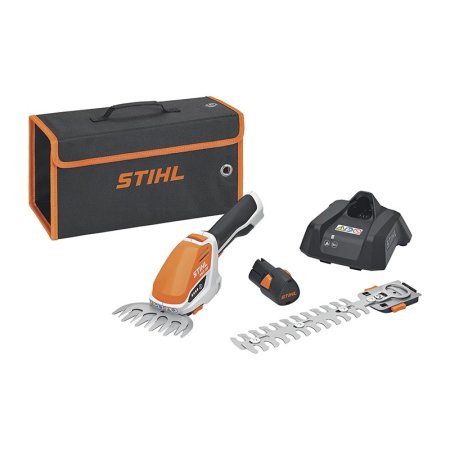
We may earn revenue from the products available on this page and participate in affiliate programs. Learn More ›
A power hedge trimmer can help keep landscape shrubs looking their best, but buying one may not be that simple. Depending on the size and scope of the hedges, a small battery-powered model might do the job, or larger specimens may require a gas-powered pole trimmer for the longer reach and increased power. We spent more than 15 hours testing seven highly rated hedge trimmers, trying to find out which tool was best all-around and which ones were better for specific tasks.
The Ego Power+ 26-inch Hedge Trimmer took our top honors thanks to its large cutting capacity and long blade. It made quick work of thick, fast-growing shoots while also making clean cuts on thin, flexible branches. But it’s not the best option in every scenario. If you need to shape up a privacy hedge or a potted topiary, you’ll want a small hedge trimmer that is better equipped. In the review ahead, we will offer some shopping considerations to bear in mind before you buy, share our observations from testing, and hopefully introduce you to the best power hedge trimmer for your yard.
- BEST OVERALL: Ego Power+ HT2601 Hedge Trimmer
↓ Jump to Review - BEST BANG FOR THE BUCK: Black+Decker LHT321 Hedge Trimmer
↓ Jump to Review - BEST LIGHTWEIGHT: Stihl HSA 45 Hedge Trimmer
↓ Jump to Review - BEST BATTERY: DeWalt DCHT820 Hedge Trimmer
↓ Jump to Review - BEST LONG-REACH: Husqvarna 122LKH Hedge Trimmer
↓ Jump to Review - BEST GAS: Echo HC-2020 Hedge Trimmer
↓ Jump to Review - BEST MINI: Stihl HSA 26 Hedge Trimmer
↓ Jump to Review
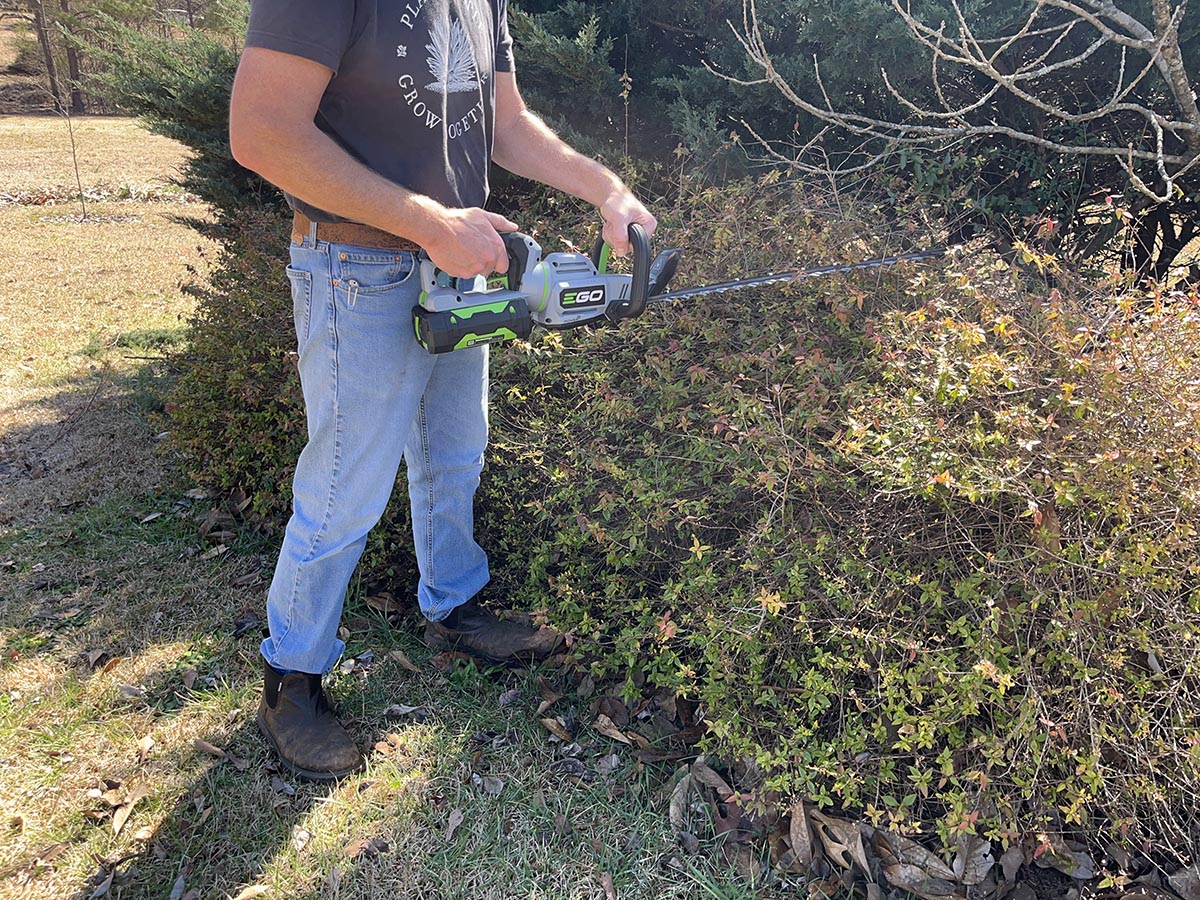
Power Hedge Trimmers Comparison Chart
| Power Source | Weight | Blade Length | |
| Ego Power+ HT2601 Hedge Trimmer | 56V battery | 9.7 pounds | 26 inches |
| Black+Decker LHT321 Hedge Trimmer | 20V battery | 7.9 pounds | 22 inches |
| Stihl HSA 45 Hedge Trimmer | 18V battery | 5.1 pounds | 20 inches |
| DeWalt DCHT820 Hedge Trimmer | 20V battery | 8.8 pounds | 22 inches |
| Husqvarna 122LKH Hedge Trimmer | 21.6 cc gas engine | 15 pounds | 21 inches |
| Echo HC-2020 Hedge Trimmer | 21.2 cc gas engine | 10 pounds | 20 inches |
| Stihl HSA 26 Hedge Trimmer | 11V battery | 2.5 pounds | 7.9 inches |
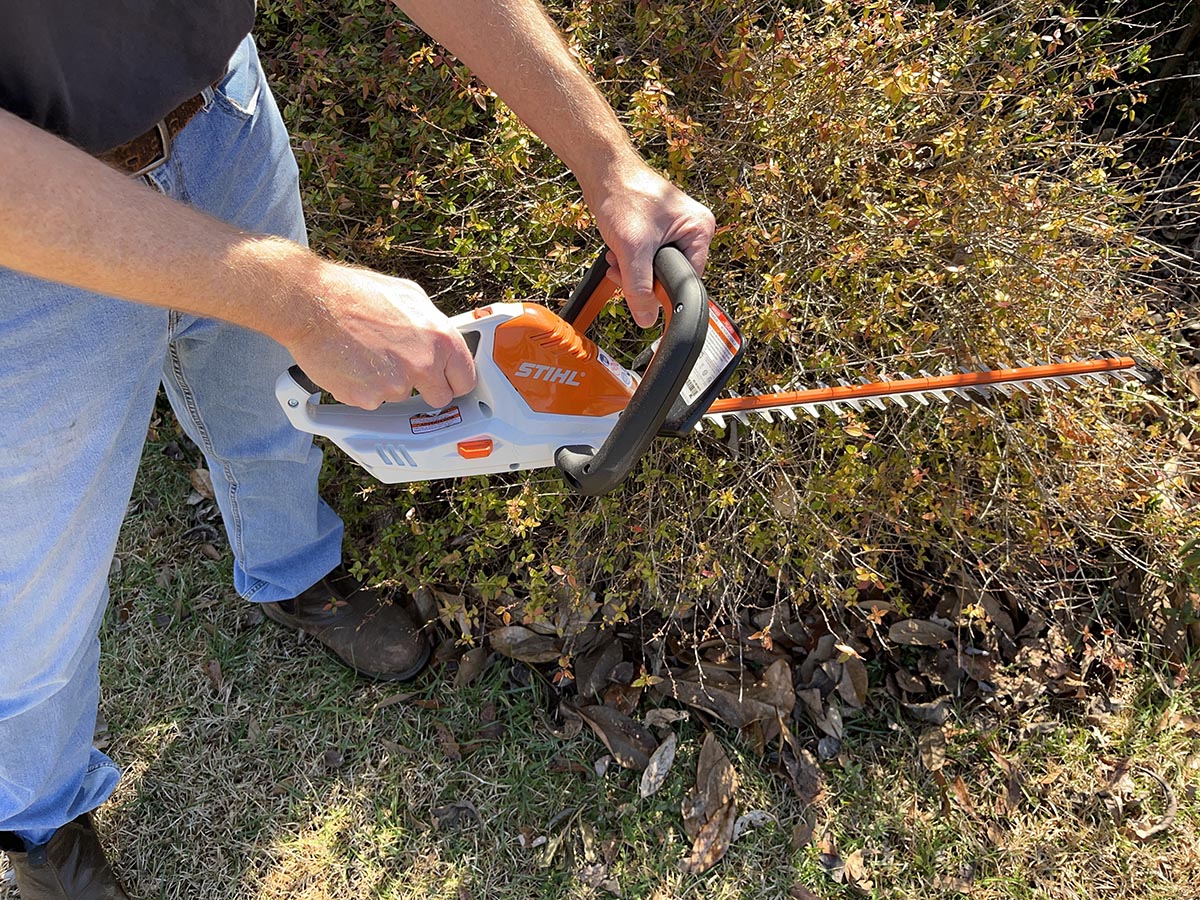
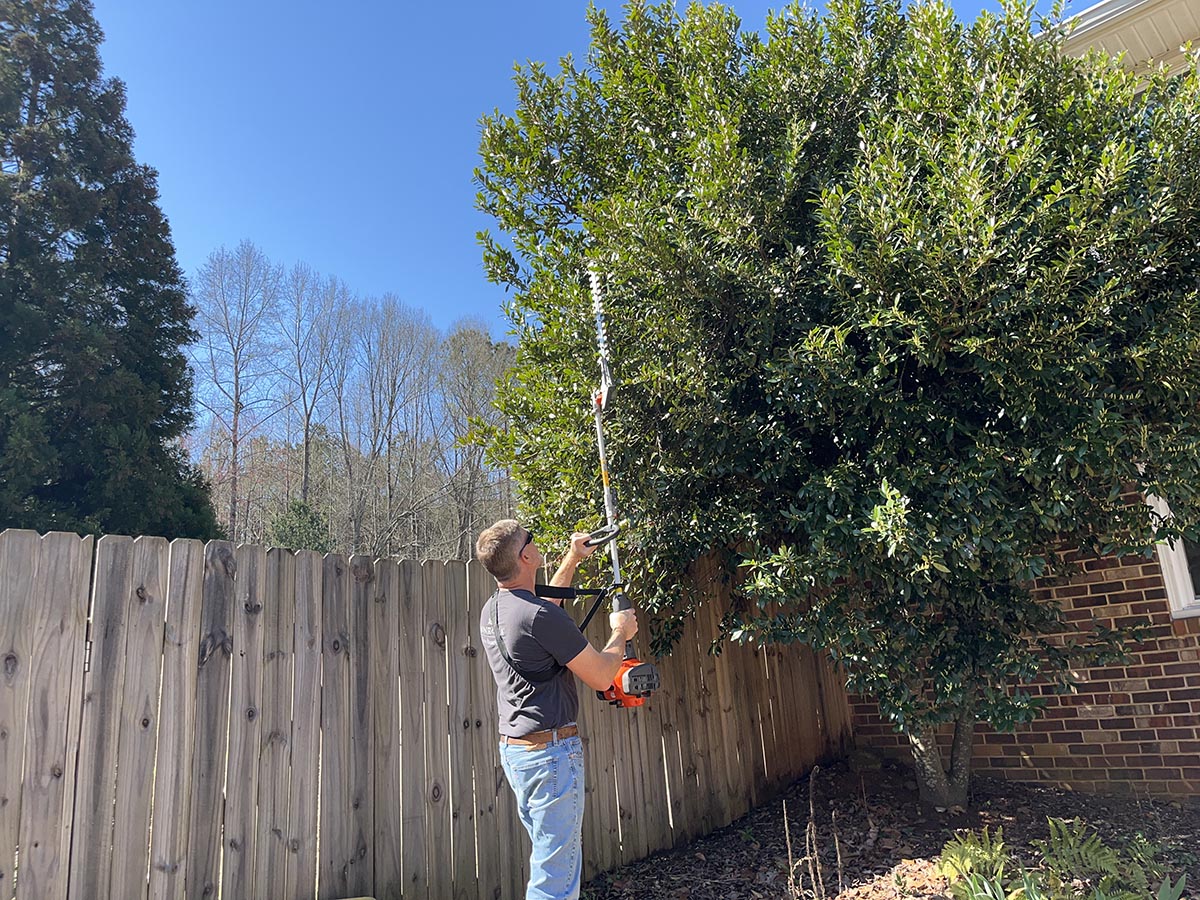
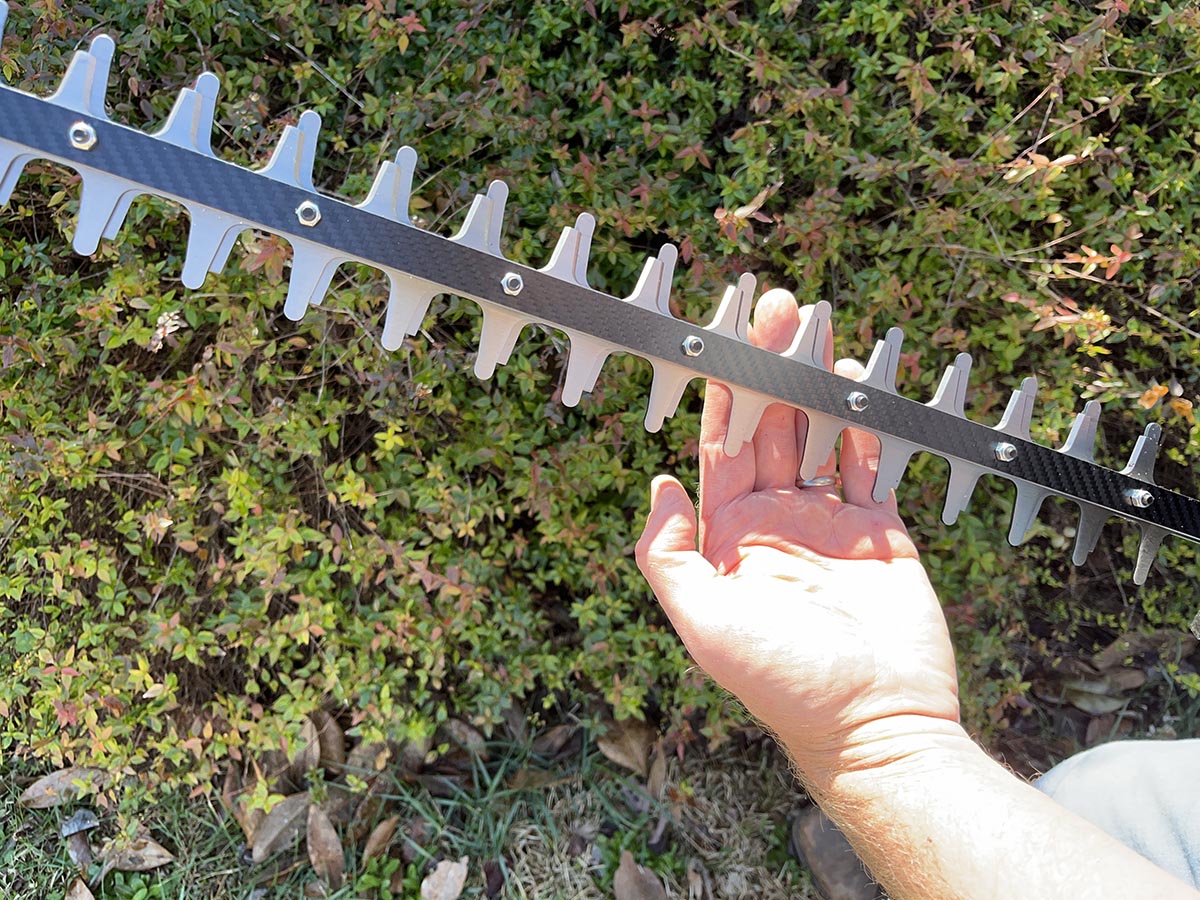
Our Top Picks
We tested the following hedge trimmers to find out more about their cutting performance, build quality, and value. Check out our individual reviews to learn more.
Best Overall
Ego Power+ HT2601 Hedge Trimmer
What We Like
- Long blade for easy flat cuts
- Wide branch cutting capacity
- Tough, lightweight carbon fiber blade rail
- 3,400 cutting strokes per minute
What We Don’t Like
- Long blade can be difficult to maneuver in tight spots
Specs
- Power source: 56V battery
- Weight: 9.7 pounds
- Blade length: 26 inches
Our Ratings: Ease of Use 4.5/5; Performance 5/5; Durability 5/5; Value 4.7/5
Need an overall good hedge trimmer that can do everything well? Consider the Ego Power+ HT2601. This 56V electric hedge shear works as hard as a gas-powered model, but it’s much quieter. It comes equipped with a 26-inch blade assembly with a lightweight carbon fiber rail and a 1.2-inch cutting capacity. The HT2601 is as effective for a light trim off the top midsummer as it is for deeply pruning shrubs ahead of the growing season.
In our tests, the Ego Power+ hedge trimmer had no trouble leveling an out-of-control holly hedge and did a beautiful job cutting back the winter-brown foliage on a bed of liriope. It was most helpful when we had a large job to do quickly, especially if that involved wide flat cuts. We got a full 70-minute run time per charge, which translated to about 90 minutes of total work time.
If there was a weak point with this tool, it was in maneuverability around curves and other unique shapes. The tip guard prevented hang ups within congested branches for the most part, but the trimmer is heavier than other battery hedge trimmers, and we had to work cautiously while working in narrow spaces.
What our tester says: “As usual, Ego Power+ did its research and turned in a solid performance. This hedge trimmer might be oversized for some jobs, but it’s just right for maintaining large square-shaped hedges. I also really like that it has the power to take down overgrown hedges for a fresh start.” —Mark Wolfe, Product Reviews tester and writer
Get the Ego Power+ power hedge trimmer at Amazon, Lowe’s, or Ace Hardware.
Best Bang for the Buck
Black+Decker LHT321 Hedge Trimmer
What We Like
- Lightweight trimmer for small projects
- Budget-friendly price
- Trims thin branches very cleanly
- 0.75-inch cutting capacity
What We Don’t Like
- Relatively short run time and long recharge time
- Not as durable as other options
Specs
- Power source: 20V battery
- Weight: 7.9 pounds
- Blade length: 22 inches
Our Ratings: Ease of Use 4.5/5; Performance 4.3/5; Durability 4/5; Value 4.7/5
The Black+Decker LHT321 cordless hedge trimmer is a great option for occasional light-duty use, and it’s a big-time money saver. The trimmer features a 22-inch blade assembly that can cut branches up to 0.75-inch thick. The kit includes a 1.5 amp hour battery and charger that powers up to 3,000 square feet of trimming per charge.
We were pleased with the Black+Decker trimmer’s cutting performance. At 2,400 strokes per minute, it was not the fastest we tested, but the cuts were nice and clean. Cutting capacity was good for maintenance, but we would not recommend it for deep cuts; it may not be up to thicker branches.
The trimmer was light enough to minimize fatigue, especially with battery life limited to about 30 minutes. The 22-inch blade maneuvered well around curves and intricate shapes and did a good job on flat planes as well. The only negatives we noted were the somewhat limited run time combined with an extremely slow battery recharge time, and the controls felt a bit clunky. For occasional use on a small property, we would go with this trimmer and take the savings.
Get the Black+Decker power hedge trimmer at Amazon, The Home Depot, or Lowe’s.
Best Lightweight
Stihl HSA 45 Hedge Trimmer
What We Like
- Very lightweight and easy to maneuver
- Fast, sharp blades cut extra clean
- Excellent run time from a small battery
- Convenient built-in battery
What We Don’t Like
- Not suitable for thick, mature branches
Specs
- Power source: 18V battery
- Weight: 5.1 pounds
- Blade length: 20 inches
Our Ratings: Ease of Use 5/5; Performance 4.7/5; Durability 5/5; Value 4.7/5
The Stihl HSA 45 cordless hedge trimmer is one of the lightest-weight and most maneuverable trimmers we tested, and it punches above its weight in terms of cutting ability. This little trimmer weighs just over 5 pounds and has soft grips for superb control and operator comfort. The 20-inch bar maneuvers smoothly around any shape, with a 0.69-inch cutting capacity for light- and medium-duty trimming. The HSA 45 includes a built-in battery for added convenience.
We used the Stihl cordless trimmer on coarse holly branches and pliable boxwood shoots, and the results were perfect in both cases. It even did a fair job when it encountered hardened deadwood branches. The cutters move at a moderate 2,500 strokes per minute, so it was not the fastest trimmer we tested, but it consistently made crisp, clean cuts.
The small cutting capacity makes the Stihl HSA 45 cordless trimmer a good choice for maintenance trimming, less so for deep cuts in thick branches. The relatively short 40-minute run time, and 210-minute charge time, render it best for small to midsize landscapes.
Get the Stihl power hedge trimmer at Acme Tools, Ace Hardware, or Stihl.
Best Battery
DeWalt DCHT820 Hedge Trimmer
What We Like
- Impressive 75 minutes of run-time per charge
- Tough and aggressive laser-sharpened cutters
- Good reach; easy to maneuver
- Dependable battery platform
What We Don’t Like
- Leaves ragged edges on larger branch cuts
Specs
- Power source: 20V battery
- Weight: 8.8 pounds
- Blade length: 22 inches
Our Ratings: Ease of Use 5/5; Performance 4.7/5; Durability 5/5; Value 4.7/5
From DeWalt, this cordless trimmer runs on a powerful 20V lithium-ion rechargeable battery that’s interchangeable with several other battery-powered DeWalt landscaping tools. The big, efficient battery on this trimmer makes a significant difference in the power and run time. In terms of actual energy stored, it falls a little behind our top pick, but it delivers a longer run time. At full power, the battery lasts up to 75 minutes. The dual-action 22-inch blades cut when moving in both directions, slicing through branches up to 0.75 inch thick, with less vibration and less noise than many traditional models.
Although it was not the lightest battery trimmer we tested, the DeWalt hedge trimmer was an excellent overall performer. The unique hooked cutter geometry worked well on everything from tough hardened dead branches to thin, pliable new growth, and the blades cut at an impressive 2,800 strokes per minute. The trimmer was easy to maneuver around different hedge profiles, and the cuts were consistently clean. For a quality tool from a dependable battery platform, we recommend the DeWalt XR 20V hedge trimmer.
Get the DeWalt power hedge trimmer at Amazon, Tractor Supply Co., The Home Depot, or Acme Tools.
Best Long-Reach
Husqvarna 122LKH Hedge Trimmer
What We Like
- Pole hedge trimmer provides extra-long reach
- Shoulder strap relieves operator fatigue
- Articulating blade for easy shaping
- Efficient attachment-capable powerhead
What We Don’t Like
- Smaller cutting capacity
Specs
- Power source: 21.6 cc gas engine
- Weight: 15 pounds
- Blade length: 21 inches
Our Ratings: Ease of Use 4/5; Performance 5/5; Durability 5/5; Value 5/5
Instead of splurging on a dedicated extended hedge trimmer that might only be necessary a couple of times each season, consider the Husqvarna 122LKH. It features an attachment-capable 216 cc, 2-cycle gas powerhead that can also power a string trimmer, a lawn edger, and a pole chainsaw attachments. The 21-inch hedge trimmer attachment has a 0.8-inch cutting capacity for general-purpose trimming. The blade pivots 180 degrees and locks into one of eleven positions for easy, accurate access to any shrub surface.
Thankfully, the 15-pound LKH122 comes equipped with a shoulder strap to alleviate the weight. In our tests, this tool actually caused less body strain and fatigue than many of the smaller options when we needed to trim overhead. With the tool grips in our hands at chest height, this long-reach hedge trimmer allowed us to trim vertically as high as 10 feet and, by pivoting the blade, to cut along a horizontal plane 8 feet above ground. We also used it to trim ground cover foliage while standing comfortably upright.
This bush trimmer came equipped with a spring-assisted recoil starter that made it super easy to crank. It also featured double-sided trimmer blades that moved extra fast and cut in both directions. It made some of the cleanest cuts of the entire test group and had no trouble cutting through material up to 0.75-inch thick. If you have a large area to cover or just a few large shrubs, this is one of the best long-reach options you can buy.
What our tester says: “Most multipurpose tools put on an ‘acceptable’ performance but rarely excel at anything in particular. The Husqvarna 122LKH Hedge Trimmer is a notable exception. It worked as well as a pro-grade hedge trimmer with the added convenience of being right-sized for homeowners. I would love to see this powerhead in action with some of the other attachments.” —Mark Wolfe, Product Reviews tester and writer
Get the Husqvarna power hedge trimmer at Amazon, SLE Equipment, or Husqvarna.
Best Gas
Echo HC-2020 Hedge Trimmer
What We Like
- Lightweight and easy to maneuver
- Cuts fast and clean
- Large cutting capacity
- Easy-start engine
What We Don’t Like
- Higher price than similar models
Specs
- Power source: 21.2 cc gas engine
- Weight: 10 pounds
- Blade length: 20 inches
Our Ratings: Ease of Use 4.5/5; Performance 5/5; Durability 5/5; Value 4.7/5
Gas hedge trimmers are the top choice for extended work and heavy-duty trimming, but they have a reputation for being heavy and loud. The Echo HC-2020 hedge trimmer offers the long run time and aggressive cutting capability required of a good gas hedge trimmer with a more user-friendly design. This machine weighs just 10 pounds and features a 20-inch blade with a 1-inch cutting capacity. The laser-sharpened double reciprocating cutters move at a blazing 3,600 strokes per minute for fast, clean cutting action.
The Echo hedge trimmer did a great job on every trimming task. It started on the second pull every time, and the engine produced less vibration through the handles than we anticipated based on similar trimmers we’ve used in the past. We used the HC-2020 for light shaping of boxwoods as well as deep renewal pruning of older holly hedges. It easily moved through all kinds of branches and foliage and left behind a clean finish.
Get the Echo power hedge trimmer at Amazon, The Home Depot, Acme Tools, or Mowers at Jacks.
Best Mini
Stihl HSA 26 Hedge Trimmer
What We Like
- Ideal size for topiaries and small hedges
- Easy one-handed operation
- Surprisingly long run time
- Changeable cutting head
What We Don’t Like
- Premium price point
Specs
- Power source: 11V battery
- Weight: 2.5 pounds
- Blade length: 7.9 inches
Our Ratings: Ease of Use 5/5; Performance 4.7/5; Durability 5/5; Value 4.7/5
For the most detailed projects, size matters. The Sthil HSA 26 is a mini hedge trimmer in the truest sense, weighing just 2.5 pounds with the 11V battery and 7.9-inch hedge trimmer blade installed. It is designed for single-hand use, with a soft, textured grip and ergonomic design. The cutters move at a quick 2,200 strokes per minute, and the battery powers up to 80 minutes of hedge shearing per charge. This is the ideal tool for shaping small topiaries and compact hedges.
We spent almost three hours trimming all over the yard with the Stihl cordless garden shear, alternating between the hedge trimmer and grass shear attachments. The hedge trimmer was conveniently sized for cleaning up the new shoots on small container-grown topiaries and keeping compact foundation shrubs shapely. It’s small enough to keep at the ready in a coat closet or other convenient spot by the front door for a quick trim. The cut accuracy and quality were excellent.
Get the Stihl mini power hedge trimmer at Northern Tool + Equipment, Acme Tools, or Blain’s Farm & Fleet.
Jump to Our Top Picks
How We Tested the Best Power Hedge Trimmers
| Products tested | 7 |
| Time spent testing | 16 hours |
| Tests performed | 6 |
| Price range | $80 to $350 |
We spent two days testing seven highly rated power hedge trimmers from six trusted tool brands as we sought out the best options for general landscape trimming and shaping. We used each tool to trim at least 500 square feet of large and small hedges, including foliage that ranged from pliable new growth to hardened inch-thick branches. Throughout the process, we evaluated each tool according to its ease of use and ability to accurately trim while following existing shrub profiles. We also noted our thoughts on durability and relative value. After testing, we recorded our observations on a scoring rubric before awarding the category winners and our top overall pick.
| Ease of Use | Performance | Durability | Value | |
| Ego Power+ HT2601 Hedge Trimmer | 4.5 | 5 | 5 | 4.7 |
| Black+Decker LHT321 Hedge Trimmer | 4.5 | 4.3 | 4 | 4.7 |
| Stihl HSA 45 Hedge Trimmer | 5 | 4.7 | 5 | 4.7 |
| DeWalt DCHT820 Hedge Trimmer | 5 | 4.7 | 5 | 4.7 |
| Husqvarna 122LKH Hedge Trimmer | 4 | 5 | 5 | 5 |
| Echo HC-2020 Hedge Trimmer | 4.5 | 5 | 5 | 4.7 |
| Stihl HSA 26 Hedge Trimmer | 5 | 4.7 | 5 | 4.7 |
What to Consider When Choosing a Power Hedge Trimmer
Before deciding on the best power hedge trimmer for your yard, it’s important to consider the power source, engine, blade sizes, and whether it’s better to use an electric hedge trimmer or whether a gas model is a more appropriate option. Read on to find out more about these factors to find the best power hedge trimmers for maintaining the trees and shrubs in your landscape.
Power Source
When searching for the best power hedge trimmer, there are two power options: gas and electric. The decision is usually based on how much power and portability are needed.
- Gas-powered hedge trimmers: These tough tools, which generally require both oil and gas to run properly, tend to work harder than their electric counterparts. The downside to more power is weight: Gas hedge trimmers may weigh more than 10 pounds, making it a challenge to reach up and around tall shrubbery.
- Electric hedge trimmers: Though they don’t provide quite as much oomph as gas-juiced models, electric trimmers are usually lighter, making them easier to wield at chest height or higher. Lower-priced corded models offer uninterrupted use but less mobility because they’re plugged into an outlet—a potential problem for larger yards if the gardener doesn’t have a lengthy extension cord. Cordless hedge trimmers use a battery to allow total freedom of movement as long as the batteries are recharged or replaced regularly.
Engine Power
Engine power is the force produced by the engine to drive the hedge trimmer blades, allowing them to cut through leaves, twigs, and small branches. The way that engine power is measured depends on the type of power hedge trimmer.
- Electric hedge trimmers have an amperage measurement that indicates the amount of energy flowing through the electric engine. The higher the amperage, the more powerful the engine. Most electric hedge trimmers range from 2.5 to 4.5 amps (A).
- Battery-powered hedge trimmers typically have a voltage rating that’s associated with the power stored and produced by the battery. The average battery for a hedge trimmer is just 20 volts (V), but some can have up to 80V.
- Gas hedge trimmers use cubic centimeters (cc) to describe the power of the engine. This measurement refers to the amount of air and fuel that are displaced by the engine during operation. The higher the number of cc, the more powerful the engine. Typically, gas hedge trimmer engines range from 21 cc to 25 cc.
Blade Length
Blades can be either single- or double-sided, and they come in a wide range of sizes, from 13 inches to 40 inches in length. Choosing the right blade size is an important step that can make hedge-trimming jobs much easier.
- 18 inches or smaller is an appropriate blade size for small hedges, weeds, and shrubs that are common in residential gardens.
- 19- to 30-inch blades are ideal for the average user. They can take on large bushes, manage full-size hedges, and trim smaller tree branches.
- 30-inch and larger blades typically fall into the commercial and professional category. These blades are for regularly maintaining large established trees, hedges, bushes, shrubs, and other vegetation.
Left-handed individuals may find it easier to use a power hedge trimmer with a double-sided blade because the majority of single-sided blades are made for right-handed users.
Fuel Capacity
The fuel capacity refers to the amount of fuel that a gas-powered hedge trimmer can hold in the fuel tank. The capacity is typically used to determine how long the trimmer can operate on a single tank of gas. Naturally, larger yards will benefit from a trimmer with a higher fuel capacity so that they can operate long enough to reliably complete the required lawn care without too many refills.
The average gas-powered hedge trimmer has a tank capacity that ranges from 10 to 16 ounces. This fuel tank will usually require a mixture of gas and oil at a ratio of about 40:1 or 50:1, though users will always want to refer to the manufacturer’s directions for the proper fuel ratio. Trimmers operate for between 45 minutes and two hours, depending on the weight of the machine, the size of the engine, and the material that’s being cut.
Battery Life
Batteries are one of the three main fuel sources for power hedge trimmers, with most models using a long-lasting lithium-ion battery that can range from 20V to 80V. The battery life of a hedge trimmer can differ depending on the weight of the trimmer, the age of the battery, and the amount of material the trimmer is cutting.
On average, a hedge trimmer battery can last between 30 minutes and an hour, and it will take between 30 minutes and two hours to fully charge. Keep in mind that some hedge trimmers don’t come with a battery or a battery charger, so users may need to purchase the battery separately. If this is the case, it’s a good idea to get two batteries so that one is always charging while the other is in use.
Cutting Capacity
Another factor to consider is the thickness of a branch that the trimmer can tackle, i.e., its cutting capacity. Most slice through branches up to a half-inch thick, though more powerful models can usually handle up to an inch in diameter. Check the size of the gap between the blade’s teeth. This is referred to as a blade gap, and the greater the gap, the higher the cutting capacity.
Most residential trimmers have a gap that ranges from an eighth to three-quarters of an inch, which is suitable for leaves, twigs, and small branches. However, professional or commercial-grade trimmers can have a blade gap wider than one inch, allowing them to take on small trees and oversize hedges.
Weight and Ease of Use
Hedge trimmers can range in weight from lightweight battery-powered options that weigh only 5 pounds to heavy gas trimmers that can weigh more than 20 pounds. If this doesn’t seem heavy at first, then a gardener will want to consider holding this amount of weight with their arms extended to the front or sides for up to two hours to determine whether it’s comfortable for longer-term use.
However, there are a few features that can make it easier to hold and control hedge trimmers, including a padded front handle that gives users a better grip on the trimmer. Telescoping poles are another great feature that reduces muscle strain by allowing the trimmer to extend out to cut branches and leaves instead of trying to stretch or climb up and down a ladder repeatedly. Also, a tool that is well-balanced from the front to the back usually offers better support and can reduce muscle fatigue.
Safety Features
When choosing a power hedge trimmer, safety should be the highest priority so that gardeners can trim the vegetation in the yard without having to worry about a hospital trip. With that in mind, manufacturers have installed several safety features to help make power hedge trimmers a safer option for managing the garden, including blade brakes, safety switches, padded front handles, and front handle shields.
- Blade brakes stop the blade as soon as the trigger is released. In an emergency, this stops the blade immediately instead of allowing it to gradually lose inertia and stop on its own.
- Safety switches prevent the accidental activation of the trimmer. The safety switch needs to be pressed down before the trigger can be used to turn on the trimmer.
- Padded front handles can help reduce muscle fatigue and strain caused by vibration and the weight of the trimmer.
- Front handle shields prevent the user’s hand from slipping off the handle into the blade.
- Blade sheaths can keep users protected from the blades, but they also serve to protect the blades from moisture, dust, and any other debris.
Tips for Using a Power Hedge Trimmer
Now that you’ve picked up your favorite hedge trimmer for your backyard landscaping ideas, it’s worth knowing a few important things about how to use it safely and efficiently. Take the following tips into consideration before picking up your new power tool for the first time.
- Sharpen your hedge trimmers—if it tears ragged edges, it’s blunt.
- Lubricate the blades before every use.
- Always hold the blade away from you.
- Take a break every now and then to prevent the motor from overheating.
- Place a tarp on the ground before starting for easy cleanup.
FAQs
Adding a power hedge trimmer to your yard maintenance arsenal can help keep vegetation under control. However, you may still have questions, such as whether a gas or electric cordless hedge trimmer is more powerful or what type of oil is best. Take a look below for the answers to these and several more frequently asked questions about hedge trimmers.
Hedge trimmers are lightweight tools made for trimming smaller branches, leaves, and vegetation. Hedge cutters are a more robust tool that cuts through much thicker branches and even the trunks of very small trees, shrubs, and hedges.
Battery-powered hedge trimmers have a limited amount of power because they must convert energy from the lithium-ion battery to the electric motor. Corded electric hedge trimmers are more powerful because they have a direct connection to a power source. However, the most powerful type of hedge trimmer is gas because of the large combustion engine that burns gas at a controlled rate to drive the blades.
It’s advised to use the oil that the manufacturer recommends. Typically this will be a 2-cycle blend such as the Briggs & Stratton 2-Cycle Easy Mix Motor Oil that is a fuel stabilizer or the semi-synthetic Husqvarna HP Synth 2-Cycle Oil.
Most residential trimmers can cut leaves, twigs, and small branches that range in thickness from 0.375 to 0.75 inches. Commercial-grade trimmers can have a blade gap wider than 1 inch, allowing them to take on small trees and oversize hedges.
The average battery for a hedge trimmer is just 20V, but some can have up to 80V. Choose the amount of power that’s appropriate for the tasks you most normally complete.
Yes. If your branches are not cutting cleanly, your trimmer most likely needs to be sharpened. Stihl recommends sharpening after every 50 hours or so of use. You can sharpen your tool yourself or bring it to a store to have it done for you.
We asked Scott McLeod, owner of Tewksbury, Massachusetts-based McLeod Landscaping, Inc., about basic maintenance. He explained that electric hedge trimmers require minimal maintenance: “Wipe the blades clean after each use and lubricate the cutting head once a season.”
According to McLeod, cutting blades should last 3 to 5 years with average homeowner use, but he adds that “the motor can last up to 10 years if properly cared for.” On the other hand, batteries lose capacity over time and may need to be replaced within 1 to 3 years, depending on use.
Shorter hedge trimmer blades are better suited for maintaining intricate shapes, curves, and smaller hedges. Longer blades are better for trimming large hedges and flat surfaces.
Meet the Tester
Mark Wolfe is a writer and product tester who spent 20 years in the nursery and landscaping industry. For more than twenty years, he mowed, edged, planted, pruned, cultivated, irrigated, and renovated beautiful landscapes. Now he tests and writes reviews about the latest outdoor power equipment, hand tools, lawn care products, and other outdoor living goods.
Additional research provided by Timothy Dale and Andréana Lefton

